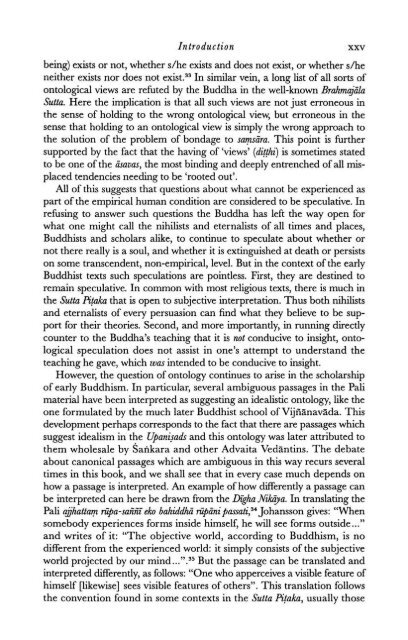Identity and Experience_Hamilton_1996
Identity and Experience_Hamilton_1996
Identity and Experience_Hamilton_1996
You also want an ePaper? Increase the reach of your titles
YUMPU automatically turns print PDFs into web optimized ePapers that Google loves.
Introduction<br />
xxv<br />
being) exists or not, whether s/he exists <strong>and</strong> does not exist, or whether s/he<br />
neither exists nor does not exist.33 In similar vein, a long list of all sorts of<br />
ontological views are refuted by the Buddha in the well-known Brahmajiila<br />
Sutta. Here the implication is that all such views are not just erroneous in<br />
the sense of holding to the wrong ontological view, but erroneous in the<br />
sense that holding to an ontological view is simply the wrong approach to<br />
the solution of the problem of bondage to samsiira. This point is further<br />
supported by the fact that the having of 'views' (di!!hi) is sometimes stated<br />
to be one of the Gavas, the most binding <strong>and</strong> deeply entrenched of all misplaced<br />
tendencies needing to be 'rooted out'.<br />
All of this suggests that questions about what cannot be experienced as<br />
part of the empirical human condition are considered to be speculative. In<br />
refusing to answer such questions the Buddha has left the way open for<br />
what one might call the nihilists <strong>and</strong> eternalists of all times <strong>and</strong> places,<br />
Buddhists <strong>and</strong> scholars alike, to continue to speculate about whether or<br />
not there really is a soul, <strong>and</strong> whether it is extinguished at death or persists<br />
on some transcendent, non-empirical, level. But in the context of the early<br />
Buddhist texts such speculations are pointless. First, they are destined to<br />
remain speculative. In common with most religious texts, there is much in<br />
the Sutta Pi!aka that is open to subjective interpretation. Thus both nihilists<br />
<strong>and</strong> eternalists of every persuasion can find what they believe to be support<br />
for their theories. Second, <strong>and</strong> more importantly, in running directly<br />
counter to the Buddha's teaching that it is not conducive to insight, ontological<br />
speculation does not assist in one's attempt to underst<strong>and</strong> the<br />
teaching he gave, which was intended to be conducive to insight.<br />
However, the question of ontology continues to arise in the scholarship<br />
of early Buddhism. In particular, several ambiguous passages in the Pali<br />
material have been interpreted as suggesting an idealistic ontology, like the<br />
one formulated by the much later Buddhist school of Vijiianavada. This<br />
development perhaps corresponds to the fact that there are passages which<br />
suggest idealism in the Upani;ads <strong>and</strong> this ontology was later attributed to<br />
them wholesale by Sankara <strong>and</strong> other Advaita Vedantins. The debate<br />
about canonical passages which are ambiguous in this way recurs several<br />
times in this book, <strong>and</strong> we shall see that in every case much depends on<br />
how a passage is interpreted. An example of how differently a passage can<br />
be interpreted can here be drawn from the Diiha NikcZya. In translating the<br />
Pali ajhattam nipa-safifii eko bahiddha ri$~iiniparsati,~~ Johansson gives: "When<br />
somebody experiences forms inside himself, he will see forms outside ..."<br />
<strong>and</strong> writes of it: "The objective world, according to Buddhism, is no<br />
different from the experienced world: it simply consists of the subjective<br />
world projected by our mind ...".35 But the passage can be translated <strong>and</strong><br />
interpreted differently, as follows: "One who apperceives a visible feature of<br />
himself [likewise] sees visible features of others". This translation follows<br />
the convention found in some contexts in the Sutta PiGaka, usually those


